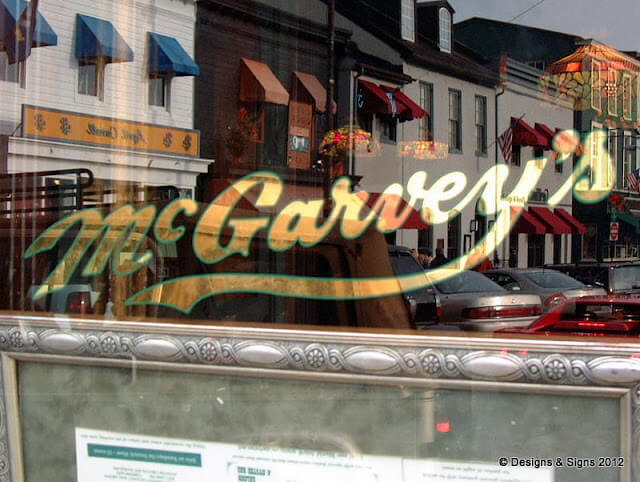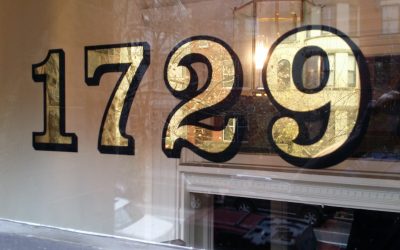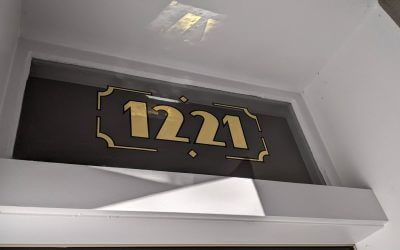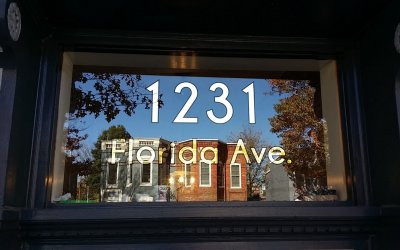In Annapolis, Maryland, you can see the traditional method of gold leafing on glass in the McGarvey’s Saloon. With the exception of a few scratches, the hand-rendered gold leaf logo has maintained its excellent condition for more than 30 years. Don’t forget that this is a bar, so let’s not lose sight of that. Using two layers of gold leaf, we apply both layers by hand. There is a backup paint that provides protection against accidental damage to the gold leaf. In order to remove any excess gold leaf, we use an eradicating brush. At last, Brendon painted by hand the thin green outline around the design. If you wish to enhance the appearance of your storefront, gold leaf on glass is a beautiful way to do it. Gilding glass with traditional methods is capable of lasting a lifetime.
About McGarvey’s
- http://www.mcgarveysannapolis.com/
- https://www.capitalgazette.com/business/ph-ac-cn-mcgarveys-0909-20160908-story.html
- https://www.capitalgazette.com/business/ac-cn-mcgarveys-bar-1228-story.html
McGarvey’s is a great spot to eat seafood and drink beer. Locals were recommending this restaurant to me, so I decided to give it a try. The oysters and crab cakes are delicious, and the beer is cold… so you can’t go wrong! We were given ice water to drink in the middle of the hectic day with 95 degree temperatures. A trainee and Alex came to our table within a short amount of time. A large bar and several rooms are part of the comfortable decor of this restaurant.
About Verre églomisé
In verre églomisé, the surface of the rear face of the glass is inlaid with gold leaf to achieve a reflective effect. French art dealer and decorator Jean-Baptiste Glomy (1711-1786) is widely credited with its revival.
Glomy’s technique for applying decorative designs to glass picture frames was relatively straightforward, using plain color and gilding. As the term has evolved over the centuries, it has become synonymous with virtually any process involving painted or gilded glass.
In pre-Roman times, back-painting glass was common. During the 13th through 16th centuries in Italy, the art underwent a significant period of development. Reliquaries and portable altars show designs formed by engraved gold leaf.
As well as the United States, it is also used throughout Europe, appearing in furniture, drinking glasses, and jewelry. Recent history documents the use of gold leaf as window signs, advertising on glass, and decorative panels.
Gilding techniques used during the great depression
In the 1920s, artists in the Blue Ridergroup began exploring this technique and transformed it from a folk art to a fine art. As a matter of fact, artists such as Kandinsky, Marc, Klee or Gabriele Münter worked with the medium of glass. In today’s world, only a few artists use the technique as their primary instrument for creating fine art. One of the most well known Irish artists who used gold leaf in her work is Yanny Petters. She has been exhibiting her wonderful work at the Shirley Sherwood Gallery, Kew Garden, London, as well as the Olivier Cornet Gallery in Dublin.
The gilding process involves fixing the silver, gold, or other metal leaf with gelatin adhesive, which produces a mirror-like, reflective surface after steaming. A design comes to life through a variety of techniques, including reverse painting before gilding, engraving into the gilded layer, or even within the glass itself. In order to paint an elaborate design such as a flower, the artist reverses their natural methodology, painting the highlights first and then the background.
One can create matte finishes by using oil-based adhesives (gold size varnish).
Verre Églomisé may also refer to gilt or distressed mirrors that lack any actual design or pattern, however this is taking the term further from its original meaning. We should call these “distressed hand-gilded mirrors.”.




